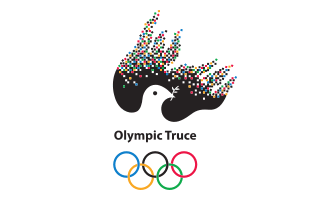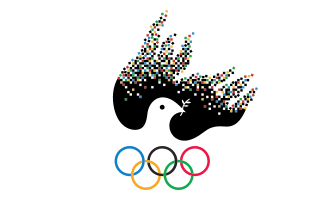
This page is part of © FOTW Flags Of The World website
Olympic Truce Flag
Last modified: 2023-06-03 by  zachary harden
zachary harden
Keywords: olympic games | truce flag |
Links: FOTW homepage |
search |
disclaimer and copyright |
write us |
mirrors
![[handcuffs protest flag]](../images/o/oly@truce.gif)
image located by Zoltan Horvath, 16 February 2014
See also:
 2014 Sochi flag; image by Zachary Harden, 20 July 2021
2014 Sochi flag; image by Zachary Harden, 20 July 2021
This is the Olympic Truce Flag designed by the Edmonton resident and
graphic designer, Wei Yew. An explanation of the flag is as follows:
"Wei Yew was invited by the International Olympic Committee to
participate in a world-wide by-invitation-only logo competition for
the centennial year of the Olympics. More than 250 design firms and
individuals submitted entries.
On the short list were his design and two submissions from the U.S.,
from which Bruce Blackburn's design was chosen for the centennial logo
and Wei's for the Olympic Truce initiative. The Truce is a revival of
the traditional moratorium on armed conflict observed during the
ancient Games. In 1993, A U.N. resolution called for countries at war
to declare a truce during a period from one week before the opening of
the Games until a week after the closing. For the first time in modern
Olympic history, flags with this Olympic Truce symbol were flown
during the 1994 Lillehammer Winter Games, and the warring factions in
Sarajevo paused to observe the Truce.
The Olympic Truce is symbolized by a dove of peace against the
traditional Olympic flame. The festive "effervescent" confetti making
up the flame suggest celebration of the human spirit. For the past 20
years, the Olympic Truce has celebrated humanity by bringing
adversaries together, such as in the 2000 Sydney Games when South
Korea and North Korea paraded into the stadium together during the
Opening Ceremony under a single flag representing the Korean
peninsula. The 2004 Athens Games witnessed the participation of
Afghanistan and Iraq, two countries bloodied by conflict,
demonstrating the unifying, reconstructive power of sport."
Darrell Neuman, 16 February 2014
 2020 Tokyo flag; image by Zachary Harden, 20 July 2021
2020 Tokyo flag; image by Zachary Harden, 20 July 2021
The symbolism of this flag was explained as follows:
"The Olympic Truce symbol was inspired by the ancient Greek tradition
of Ekecheria, when fighting stopped to allow warriors to compete
against one another in athletic events," says Yew. Yew created the
truce logo after being one of 200 individuals and companies from 75
countries invited by the International Olympic Committee to design a
symbol marking the 1996 Olympic Centennial.
He was one of three finalists, and while he didn't win, he was later
told his work was "particularly intriguing," and was invited to create
a "Truce" work that would be used not just once, but at all future
Olympics.
"The logo features a dove of peace against the traditional Olympic
flame, made up of festive, effervescent confetti to suggest
celebration of the human spirit," says Yew.
To celebrate 2014's Year of the Horse, as well as the 25th Olympic
Arts Festival in Calgary during the 1988 Winter Olympics and his own
company's 33 years of design practice in Canada, Yew is staging a Feb.
12 fundraiser for CKUA in the radio station's building on Jasper
Avenue.
Between Feb. 13 and 27, a multi-disciplinary exhibition of Yew's work
will also be featured in the CKUA foyer.
The exhibition will display creations that have propelled the
Singapore-born designer to international fame since his arrival in
Canada in 1976.
Some of my favourite highlights of Yew's career include the 1985
Communications Arts magazine design award for his Edmonton Valley Zoo
logo, which features its elephant mascot. That year, only six logos
were chosen from more than 10,000 submissions from around the world.
Yew later snatched from under the noses of Calgary designers a
$2-million design contract to showcase the 1988 Calgary Olympics Art
Festival. (He opened an 'office' in Calgary "to take the heat off" and
brought the project home $200,000 under budget.)
In 1991, he was invited by the IOC to produce a book, The Olympic
Image -- The First 100 Years, to mark the Olympic centenary. The book
took five years of research.
Yew, who has taught at the University of Alberta and MacEwan
University and has lectured extensively, also designed multimedia
displays that won Edmonton both the 2001 ITU World Triathlon
Championships and the IAAF World Athletics Championships.
Yew wins design competitions and awards every year. But 2012 was a
special year for him. "I was delighted to be recognized with a Queen
Elizabeth II Diamond Jubilee Medal," he says.
Many Edmonton charities have benefited from the designer's talents,
but the CKUA fundraiser will receive a special gift. "I have the only
Olympic Truce flag existing outside the Olympic family," says Yew. "We
will auction it."
Yew hopes his Olympic Truce flag might bring about a break in the
Syrian conflict.
"For the past 20 years, the Olympic Truce has celebrated humanity by
bringing adversaries together, such as in the 2000 Sydney Games when
South Korea and North Korea paraded into the stadium together under a
single flag representing the Korean Peninsula," he says.
"The 2004 Athens Games witnessed the participation of Afghanistan and
Iraq, two countries bloodied by conflict, demonstrating the unifying,
reconstructive power of sport.
"I hope the Syrian Olympic Committee will remind its government about
its signatory pledge to the Olympics. I am keeping my fingers crossed
as this is the beginning of the first week of the truce before the
opening of the Games."
Source:
http://www.edmontonjournal.com/sports/Nick+Lees+Locally+designed+Olympic+Truce+flag+flies+again/9459846/story.html
Darrell Neuman, 16 February 2014
 zachary harden
zachary harden

 zachary harden
zachary harden
![[handcuffs protest flag]](../images/o/oly@truce.gif)
 2014 Sochi flag; image by Zachary Harden, 20 July 2021
2014 Sochi flag; image by Zachary Harden, 20 July 2021 2020 Tokyo flag; image by Zachary Harden, 20 July 2021
2020 Tokyo flag; image by Zachary Harden, 20 July 2021